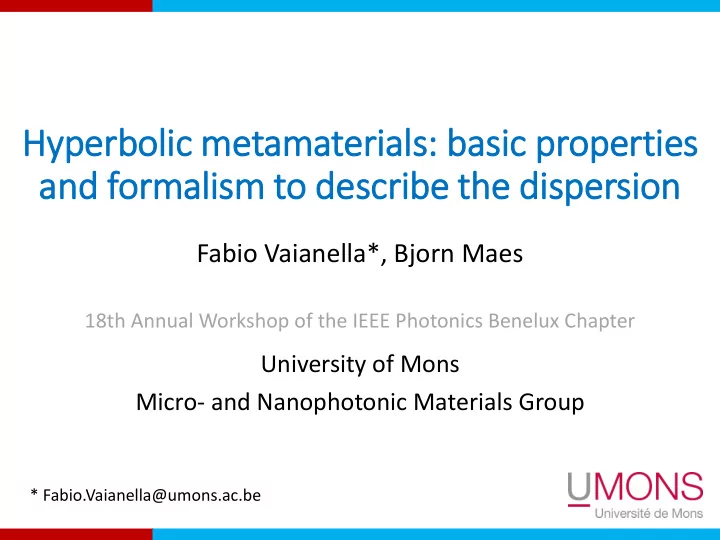

Hyperbolic metamaterials: : basic ic properties and formalism to describe the dis ispersion Fabio Vaianella*, Bjorn Maes 18th Annual Workshop of the IEEE Photonics Benelux Chapter University of Mons Micro- and Nanophotonic Materials Group * Fabio.Vaianella@umons.ac.be
Summary • Hyperbolic properties • Elementary excitations • Nanorods
Anisotropic medium Periodic subwavelength metal-dielectric multilayer structure: uniaxial extremely anisotropic medium Ag ~ 10 nm 𝜁 ∥ 0 0 z 0 𝜁 ∥ 0 𝜁 = TiO2 0 0 𝜁 ⊥ x
Anisotropic medium Periodic subwavelength metal-dielectric multilayer structure: uniaxial extremely anisotropic medium Ag ~ 10 nm 𝜁 ∥ 0 0 z 0 𝜁 ∥ 0 𝜁 = TiO2 0 0 𝜁 ⊥ x Bruggeman’s effective medium theory: Maxwell’s equation with plane waves 𝜁 ∥ = 𝑔𝜁 𝑛 + (1 − 𝑔)𝜁 𝑒 2 2 𝑙 ∥ + 𝑙 ⊥ 2 = 𝑙 0 𝜁 𝑛 𝜁 𝑒 𝜁 ⊥ 𝜁 ∥ 𝜁 ⊥ = 𝜁 𝑛 (1 − 𝑔) + 𝜁 𝑒 𝑔 Extraordinary or TM wave dispersion Fill fraction of metal
Effective permittivity Effective permittivity 𝜁 ⊥ For example: f = 1/3 𝜁 ∥ Wavelength (µm)
Effective permittivity 𝜁 ∥ . 𝜁 ⊥ < 0 possible Effective permittivity 𝜁 ⊥ 2 2 = 𝜕 2 𝑙 ∥ + 𝑙 ⊥ For example: 𝑑 2 𝜁 ⊥ 𝜁 ∥ f = 1/3 𝜁 ∥ Hyperbolic isofrequency contour ! Wavelength (µm)
Effective permittivity 𝜁 ∥ . 𝜁 ⊥ < 0 possible Effective permittivity 𝜁 ⊥ 2 2 = 𝜕 2 𝑙 ∥ + 𝑙 ⊥ For example: 𝑑 2 𝜁 ⊥ 𝜁 ∥ f = 1/3 𝜁 ∥ Hyperbolic isofrequency contour ! Wavelength (µm) λ = 500 nm λ = 700 nm Elliptic Hyperbolic
Types of hyperbolic metamaterials k z k z k x k x k z k y 𝜁 ∥ > 0 ; 𝜁 ⊥ < 0 𝜁 ∥ < 0 ; 𝜁 ⊥ > 0 Type I Type II
Applications Enhanced spontaneous emission: High-resolution subwavelength imaging, Extremely high Photonic Density Of States (PDOS) Hyperlens : no diffraction limit Galfsky, T. et al., Optica, vol. 2, 62-65. (2015) Liu, Z. et al., Science, vol. 315, 1686. (2007) And many others: extremely confined waveguide, cavities, negative refraction ,…
Limits of effective medium theory EMT 𝑙 ∥ /𝑙 0
Limits of effective medium theory EMT 𝑙 ∥ /𝑙 0 Origin of hyperbolic properties: plasmonic Field extremely confined Strong variation of the field on the scale of a single layer
Limits of effective medium theory EMT 𝑙 ∥ /𝑙 0 D = 27 nm Brillouin zone: 𝜌 𝐸 Origin of hyperbolic properties: plasmonic Field extremely confined Strong variation of the field on the scale of a single layer
Limits of effective medium theory EMT D = 9 nm 𝑙 ∥ /𝑙 0 D = 27 nm Brillouin zone: 𝜌 𝐸 Origin of hyperbolic properties: plasmonic Field extremely confined Strong variation of the field on the scale of a single layer
Dispersion EMT 0 (Hz) 𝑔 𝑙 ∥ /𝑙 0
Dispersion EMT 0 (Hz) Exact 𝑔 𝑙 ∥ /𝑙 0
Dispersion EMT 0 (Hz) Exact Typical plasmon saturation 𝑔 𝑙 ∥ /𝑙 0
Dispersion EMT 0 (Hz) Exact Typical plasmon saturation 𝑔 Interesting from the point of view of isofrequency 𝑙 ∥ /𝑙 0
Hyperbolic mode 0 (Hz) 𝑔 𝑙 ∥ /𝑙 0 𝑙 ∥ /𝑙 0
Hyperbolic mode 0 (Hz) Hyperbolic mode always exists! 𝑔 𝑙 ∥ /𝑙 0 𝑙 ∥ /𝑙 0
Origin of hyperbolic dispersion Ag TiO2 Coupling between Coupling between gap plasmon mode? slab plasmon mode? More coupling of SPPs through metal or dielectric?
Origin of hyperbolic dispersion: coupling of elementary excitation 0 (Hz) 𝑔 𝑙 ∥ (𝑛 −1 )
Origin of hyperbolic dispersion: coupling of elementary excitation
Origin of hyperbolic dispersion: coupling of elementary excitation
Holes in multilayer structure y x Rectangular nanorod array, still hyperbolic?
Single nanorod mode 0 (Hz) 𝑔 𝑙 ∥ /𝑙 0
Single nanorod mode 0 (Hz) 𝑔 𝑙 ∥ /𝑙 0
Nanorod array 0 (Hz) 𝑔 𝑙 ∥ /𝑙 0
Nanorod array 0 (Hz) Hyperbolic mode always exist too 𝑔 𝑙 ∥ /𝑙 0
Conclusions New opportunities for photonics : Extremely high index, high PDOS, … Hyperbolic properties originate from coupling of elementary excitations Extremely confined Lot of losses. Still much work to do
Thank you for your attention This work is financially supported by the F.R.I.A.-F.N.R.S.
Recommend
More recommend